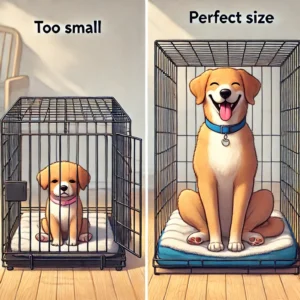A dog crate is more than just a containment tool—it serves as your pet’s safe haven, their private retreat, and an essential part of training. But how much room should your dog have in their crate? The size and fit of the crate can greatly influence your dog’s comfort, safety, and sense of security. In this guide, we’ll explore the importance of crate sizing, the factors to consider when choosing a crate, and expert tips for getting it just right.
Why Crate Size Matters
Proper crate sizing is crucial for several reasons. A crate that’s too small can make your dog feel confined and uncomfortable, leading to stress and behavioral issues. On the other hand, an oversized crate might not provide the sense of security your dog craves and could hinder house-training efforts. Striking the right balance ensures your dog feels both comfortable and secure.
Ideal Room in a Dog Crate
1. Enough Space to Stand, Turn, and Lie Down
The golden rule is to provide enough space for your dog to:
- Stand up without hitting their head.
- Turn around comfortably.
- Lie down and stretch out.
2. Avoid Excessive Extra Space
While spacious crates might seem appealing, they can encourage unwanted behaviors such as using one side as a bathroom area. Dogs instinctively avoid soiling their sleeping area, which is why snug but comfortable sizing is ideal.
How to Measure Your Dog for a Crate
1. Measure Length
- Start from the tip of your dog’s nose to the base of their tail.
- Add 2–4 inches to this measurement to allow room for movement.
2. Measure Height
- Measure your dog from the ground to the top of their head or ears when standing.
- Add 2–4 inches to ensure your dog has headroom.
3. Consider Their Build
- For dogs with long tails or those who prefer stretching out, slightly larger dimensions might be necessary.
Choosing the Right Crate Size for Your Dog’s Breed

Different breeds require different crate sizes. Here are examples of popular breeds and recommended crate dimensions:
| Dog Breed | Crate Size (inches) |
|---|---|
| Chihuahua | 18–22 inches |
| Beagle | 24–30 inches |
| Labrador Retriever | 36–42 inches |
| German Shepherd | 42–48 inches |
| Great Dane | 54+ inches |
Once you’ve measured your dog and determined the ideal crate size, you can find a wide variety of high-quality options, like this durable and adjustable dog crate.
Crate Types and Their Impact on Space
1. Wire Crates
Wire crates are adjustable and versatile, often coming with dividers to accommodate growing puppies.
2. Plastic Crates
Plastic crates are more enclosed, making them ideal for travel but less adjustable.
3. Soft-Sided Crates
Best for small breeds or temporary use, these crates prioritize comfort over rigid space.
4. Heavy-Duty Crates
Designed for larger or more destructive dogs, these crates focus on durability and secure containment.
Puppy Growth and Adjustable Crates
If you’re crate training a puppy, consider their future size. Adjustable crates with dividers are a smart investment, allowing you to resize the crate as your puppy grows. This approach saves money and ensures the crate remains appropriately sized during different growth stages.
Signs Your Dog’s Crate Is the Wrong Size
1. Crate Too Small
- Your dog seems cramped.
- They appear restless or whine frequently.
- Physical discomfort, such as difficulty turning around.
2. Crate Too Large
- Accidents occur in one corner of the crate.
- Your dog seems anxious rather than secure.
- Excessive pacing or restlessness.
Tips for Enhancing Crate Comfort
- Add Soft Bedding: Ensure the crate floor is padded with a comfortable, washable mat or blanket.
- Incorporate Familiar Items: Include your dog’s favorite toys or a t-shirt with your scent for added security.
- Create a Cozy Environment: Use crate covers or position the crate in a quiet area to minimize distractions.
- Ensure Proper Ventilation: Particularly important for enclosed crates.
Common Crate Sizing Mistakes to Avoid
- Guessing Measurements: Always measure your dog accurately rather than estimating.
- Ignoring Growth: For puppies, failing to account for growth can lead to frequent crate replacements.
- Choosing Based on Looks Alone: Focus on functionality and comfort rather than aesthetics.
- Not Testing Fit: Ensure your dog has enough room before committing to a purchase.
When to Transition from Crate Training
Crate training isn’t a permanent solution for all dogs. As your pet becomes house-trained and more disciplined, you might reduce crate use. However, some dogs continue to enjoy their crates as a lifelong safe space.
FAQs About Dog Crate Sizing
1. How can I tell if my dog’s crate is too small?
If your dog cannot stand up, turn around, or lie down comfortably, the crate is too small. Restlessness, whining, and visible discomfort are key signs.
2. Should I get a bigger crate for my growing puppy?
Opt for an adjustable crate with dividers, allowing you to resize it as your puppy grows. This saves money and ensures a perfect fit at every stage.
3. Can a crate be too big for a dog?
Yes, overly large crates can make dogs feel less secure and hinder house training, as they may use one area for sleeping and another for eliminating.
4. How do I choose the right crate size for my dog’s breed?
Refer to breed-specific sizing guidelines, and always measure your dog’s length and height to ensure an accurate fit.
5. Do dogs like having limited space in their crates?
Dogs appreciate a cozy, den-like environment, which mimics the security of a natural den. Limited but comfortable space helps them feel safe.
6. What happens if my dog doesn’t like their crate?
Gradually introduce the crate with positive reinforcement, treats, and familiar items. Avoid forcing your dog inside, as this can create negative associations.
Conclusion
Ensuring your dog has the right amount of room in their crate is key to their comfort, safety, and well-being. By accurately measuring your dog and selecting the appropriate crate type and size, you’ll create a cozy and secure environment that supports both training and relaxation. Remember, a properly sized crate can be a sanctuary for your furry friend, enhancing their overall happiness and sense of security.






